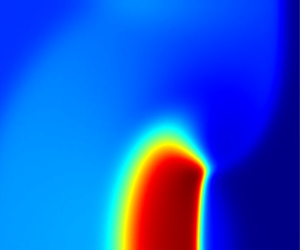Article contents
Contribution of viscosity to the circulation deposition in the Richtmyer–Meshkov instability
Published online by Cambridge University Press: 15 May 2020
Abstract

This study focuses on the process of the circulation deposition in the Richtmyer–Meshkov instability (RMI). The growth rate of circulation and its sources are theoretically and numerically studied to reveal the physical mechanism of the viscosity in the circulation deposition process. We derive a predicting model of the circulation rate for RMI. More importantly, all the contributing sources are separately predicted. Particularly, the viscous source, which previously lacked theoretical or numerical investigations, is efficiently predicted. The RMI problems in a large range of initial conditions are simulated with the direct simulation Monte Carlo (DSMC) method to verify our predicting model and further reveal the circulation deposition mechanism. The DSMC simulations provide reliable quantification of the circulation deposition (especially viscous contribution) for RMI due to its molecular nature. Our model predicts the circulation rate, baroclinic and viscous sources accurately for all the cases in comparison with the simulations. A new physical insight into the mechanism of viscosity in RMI is provided. Unlike the previous understandings that nearly all circulation deposition in RMI comes from the baroclinic source, this study reveals the hidden positive contribution of the viscous source, especially for high Mach number conditions (up to 11 % of total circulation rate). For RMI, the large viscosity gradient inside the shock waves plays a crucial role in the circulation deposition even under high Reynolds number conditions. Our study also provides exciting opportunities to further understand the viscous contribution to the vorticity dynamics in the reshocked RMI and shock wave–turbulence interactions.
JFM classification
- Type
- JFM Papers
- Information
- Copyright
- © The Author(s), 2020. Published by Cambridge University Press
References
- 12
- Cited by




